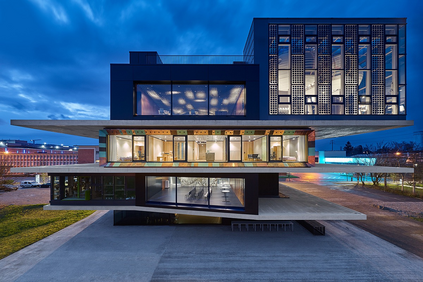With more and more data being collected, data-driven modeling methods have been gaining in popularity in recent years. While physically sound, classical gray-box models are often cumbersome to identify and scale, and their accuracy might be hindered by their limited expressiveness. On the other hand, classical black-box methods, typically relying on Neural Networks (NNs) nowadays, often achieve impressive performance, even at scale, by deriving statistical patterns from data. However, they remain completely oblivious to the underlying physical laws, which may lead to potentially catastrophic failures if decisions for real-world physical systems are based on them. Physically Consistent Neural Networks (PCNNs) were recently developed to address these aforementioned issues, ensuring physical consistency while still leveraging NNs to attain state-of-the-art accuracy. In this work, we scale PCNNs to model building temperature dynamics and propose a thorough comparison with classical gray-box and black-box methods. More precisely, we design three distinct PCNN extensions, thereby exemplifying the modularity and flexibility of the architecture, and formally prove their physical consistency. In the presented case study, PCNNs are shown to achieve state-of-the-art accuracy, even outperforming classical NN-based models despite their constrained structure. Our investigations furthermore provide a clear illustration of NNs achieving seemingly good performance while remaining completely physics-agnostic, which can be misleading in practice. While this performance comes at the cost of computational complexity, PCNNs on the other hand show accuracy improvements of 17-35% compared to all other physically consistent methods, paving the way for scalable physically consistent models with state-of-the-art performance.
翻译:随着越来越多的数据被收集,数据驱动建模方法近年来变得越来越受欢迎。虽然经典的灰盒子模型在物理上是合理的,但往往难以识别和扩展,并且其精度可能会受到其有限的表达能力的限制。另一方面,经典的黑盒子方法,通常依靠神经网络(NNs),现在通常可以从数据中推导出统计模式而实现令人印象深刻的性能,即使在规模方面也是如此。然而,它们仍然完全忽略了潜在的物理定律,如果基于它们做出针对真实世界物理系统的决策,可能会导致潜在的灾难性失误。近期开发出物理一致神经网络(PCNN),以解决这些前述问题,它们确保物理一致性,同时利用NNs实现最先进的精度。在这项工作中,我们扩展了PCNNs以对建筑温度动态进行建模,并提出了与经典的灰盒和黑盒方法的彻底比较。更准确地说,我们设计了三个独特的PCNN扩展,以证明其架构的模块化和灵活性,并正式证明其物理一致性。在所呈现的案例研究中,显示PCNNs实现了最先进的精度,即使是相对限制的结构,也优于经典的基于NN的模型。我们的调查进一步提供了NNs实现看似良好的性能,同时完全忽略物理定律的明显例证,这在实践中可能会是误导性的。虽然这种性能以计算复杂度为代价,但 PCNNs相比其他所有物理一致方法还实现了17-35%的精度提高,为实现具有最先进性能的可扩展物理一致模型铺平了道路。










